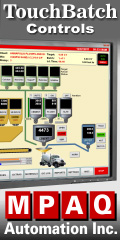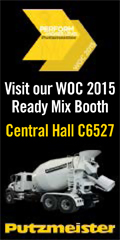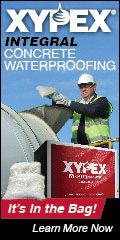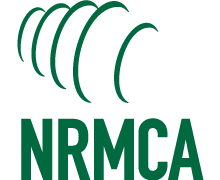
| Archive | nrmca.org | E-Store | Conferences & Events | Certifications | InFocus | Membership Directory |
NRMCA Attends ASTM Committee Meetings, Provides Updates The following is a summary of activity at the ASTM meeting of Committees C09 on Concrete and C01 on Cement attended by NRMCA staff in Jacksonville, FL:
C09.20 Concrete Aggregates - A new rapid test method to determine the methylene blue index (MBI) of aggregate was approved and is now available – ASTM C1777 - Rapid Determination of the Methylene Blue Value for Fine Aggregate or Mineral Filler Using a Colorimeter. The test is considered simpler, more accurate and less subjective than an existing AASHTO method. The purpose of the test is to identify the presence of active clay minerals in aggregates or in mineral fillers. A proposed revision to specifically include definition of a term "recycled aggregate" in Specification ASTM C33, with the intent to indicate that these materials are permitted received some negative votes, but the feedback will be used to move this forward. No changes to the existing requirements in C33 for aggregates were proposed. A specification for mineral fillers for use in concrete continues to progress through the ASTM balloting process. This specification will support the use of mineral fillers in concrete, which may be used in self-consolidating concrete or for other purposes. The subcommittee is considering alternative less hazardous heavy liquids for determining lightweight particles in aggregates (ASTM C123).
C09.24 Supplementary Cementitious Materials - On ASTM C618 Specification for Fly Ash several revisions were discussed – removing the note regarding testing at a higher fly ash dosage (similar to project) for the autoclave test, eliminating the composition based differentiation between Class C and Class F and allowing co-combustion of non-coal fuels as well as non-organic additions in the boiler that facilitate fly ash manufacture. Ballot items are expected prior to the next ASTM meeting. A new specification for alternative SCMs that will be qualified using the C1709 guide is being planned.
C09.26 Chemical Reactions - The subcommittee is evaluating whether the C1293 test method variability will justify reporting to the nearest 0.001%. Some subcommittee members feel it should be to the nearest 0.01% as required in C1567. However, the C1293 limit in the appendix is 0.04% and not 0.040%. Test method precision should be considered while setting reporting and specification limits. A task group was established to develop a recommendation. New business items planned include:
1. Introduction of "as is" aggregate grading option in C1260, C1293, and C1567 tests; 2. Permitting the use of C595 and C1157 cements in C1293 and C1567; 3. Modifications to C1567 to evaluate the effectiveness of lithium admixtures based on Corps of Engineers standard CRD C662; 4. Changing the precisions statement for the ASR tests to include language of range among the three prisms averaged for a test result; and 5. Eliminating the requirement to place test specimens in a moist room for 16 hours prior to the reading for C1293. There was a presentation on micro concrete prism test which is yielding promising results and has helped classify aggregates and select SCM levels similar to the C1293. The main advantage is that this test can be completed in 56 days as opposed to 1-2 years for C1293. This test has been drafted as an AASHTO draft. C09.40 Ready Mixed Concrete - There were some minor revisions to ASTM C94 approved. The main part of the meeting was devoted to resolving several negative votes on a new proposed specification for reuse of returned concrete. This effort was successful and the specification will be revised and forwarded to the next step in the balloting process. The subcommittee decided a few years ago that this topic is better addressed in a separate specification that can be called out from ASTM C94, rather than incorporating requirements in C94.
The subcommittee continues to work on other revisions to C94 to include revisions to the scope of the document, changes to the air content table, several revisions to the section on batching concrete, revisions to the annex on mixing uniformity and on the appendix for strength overdesign.
C09.49 Pervious Concrete - A proposal to use the Marshall hammer instead of proctor hammer to consolidate ASTM C1688 specimens for fresh density has been approved at the subcommittee and will now go to main. The issue of conducting C1701 Field Infiltration Rate testing twice at a given location on the same day has been clarified at the subcommittee and will now go to main. A new ISO standard is being developed that is a lab infiltration rate test.
C09.50 Risk Management for Alkali Aggregate Reactions (AAR) - The new practice "Determining Reactivity of Concrete Aggregates and Minimizing Risk of Deleterious Expansion" has been balloted in the main committee and drew multiple negatives. Some of those negatives were considered.
C09.60 Fresh Concrete Tests - A revision was approved to ASTM C172 to address sampling from volumetric mixers. A revised flowchart will be included in the test method for the volumetric air content measurement (C173). An involved inter-laboratory study has been completed to develop a precision statement for the pressure air method, C231. It was noted that AASHTO will address revisions to AASHTO T318 for measurement of water content of fresh concrete using the microwave oven. The revision will account for aggregate absorption and address the precision statement. ASTM will not develop a separate test method. A presentation was made on the difference in tests when samples are obtained with one or two portions from a concrete batch. No significant difference was observed in the test results. A ballot will be considered to permit obtaining a sample with one portion (rather than a composite sample).
C09.61 Strength - Revisions were approved to C469 for measuring the elastic modulus of concrete. Revisions were approved to C39 to include the procedures for using unbonded caps – these procedures will be removed from C1231. Revisions in the works include permitting the slump portion of a sample for other tests in C192 (lab testing). This concept was rejected for field tests. Other revisions discussed include changing the transportation time for cylinders from the field to the lab, provided initial curing conditions are maintained, and allowing the use of smaller beam sizes – 4 x 4 x 14 inches for flexural tests. Because of a difference in measured flexural strength of small size beams, it was suggested that this be addressed in a specification rather than include a correction factor in the test method (C78 and C293). Use of smaller beam size is proposed based on research by FHWA.
C09.66 Fluid Penetration - This subcommittee has recently published a new test standard for determination of One-Point Bulk Water Sorption of Dried Concrete (ASTM C1757-13). Two new test methods are close to being finalized:
1. Surface resistivity using Wenner probe which can be used for concrete quality assurance; and 2. Mass loss vs. time for one-dimensional drying of saturated concrete which can be used in service life prediction models. The subcommittee reviewed several negatives and will reissue revised versions of these standards for future ballots. More recent data from an inter-laboratory study was reviewed and might be used to revise the precision statement of ASTM C1202 – the rapid chloride permeability test. No significant improvement in the precision compared to that in the current standard is evident from these data. The C1202 test needs vacuum saturation (VS) while the Wenner probe test does not. It was discussed if VS can affect the results since it saturates the air voids as well. A new draft standard for bulk electrical resistivity was circulated. Three commercial equipment already exist for this test method. C09.67 Resistance to Environment - A new draft standard for deicer salt scaling test that is more reproducible in the field than ASTM C672 was presented. This will be balloted before the next ASTM meeting.
C09.98 Evaluation of Laboratories - Revisions to C1077 are addressing certification requirements for technicians and supervisors and the required tests for personnel involved in field tests and laboratory tests. Some of these revisions have implications to inspection and accreditation of laboratories.
C01 Cement - Revisions are in the works for ASTM C595 on Blended Cements to simplify the structure of the standard. These changes are made in concert to ensure harmonizing the equivalent AASHTO specification for blended cements. Other changes include a method for evaluating sulfate resistance of Portland limestone cement (Type IL) and incorporate the use of isothermal calorimetry and applicable specification criteria for cement heat of hydration.
Workshops and Symposiums - On Sunday, December 8 ASTM C09 Committee sponsored a 2-hour workshop titled Product Category Rules (PCR), Environmental Product Declarations (EPD) and Other Aspects of Sustainable Process and Resilient Materials. Presentations were made by Rich Szecsy with the Texas Concrete and Aggregates Association and Chris Surak, the ASTM manager for the program. The existence of product category rules for concrete developed by the Carbon Leadership Forum was recognized and it was indicated that this was being updated based on input from ASTM. ASTM is developing PCRs for portland cement, slag cement, masonry block, precast concrete and various other materials. ASTM is a program operator serving as a third-party verifier of a product EPD. The example of US Concrete’s EPDs for concrete was discussed. NRMCA served as the program operator for verifying its EPD. It was stressed that the pressure to generate EPDs was imminent with the release of LEED version 4.
A 4-hour symposium was held on Ultra High Performance Concrete (UHPC). There were several presentations from academia, industry and public officials and the main theme was the need for new test methods or revisions to existing methods to permit the widespread use of UHPC.
C09 Centennial - At the next meeting of ASTM Committee C09 in Toronto there will be a celebration of the committee’s 100-year anniversary. A dinner celebration is being planned for Monday, June 23, 2014. Companies are being solicited for sponsoring this event.
For more information, contact NRMCA's Colin Lobo at clobo@nrmca.org or Karthik Obla at kobla@nrmca.org. |
|
|







